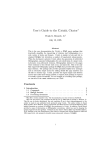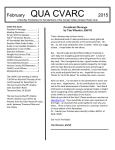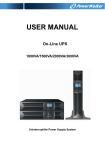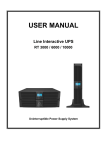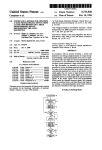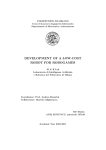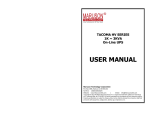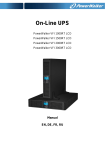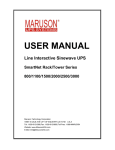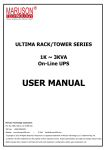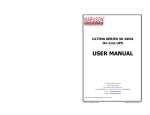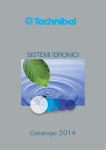Download USER MANUAL
Transcript
5. Transportation and Storage 5.1 Please transport the UPS only in the original packaging. 5.2 The UPS must be stored in the room where it is ventilated and dry. TACOMA LV SERIES 1K ~ 3KVA On-Line UPS USER MANUAL Maruson Technology Corporation P.O. Box 1986, Walnut, CA 91788 USA Toll Free: 1-888-MARUSON Website: www.MarusonUSA.com | E-Mail: [email protected] *Copyright © 2012 All Rights Reserved. Maruson® is a registered trademark of Maruson Technology (U.S. Trademark Reg. No. 3,150,957). All other trademarks are the property of their respective owners. Product specifications are subject to change without notice. Battery backup time is based on half load and varies with equipment, configuration, battery age, temperature, etc. 614-08066-00 34 CONTENT 1. PRODUCT INTRODUCTION ........................................................... 1 1.1 FUNCTIONS DESCRIPTION ............................................................................... 1 1.2 MODE DESCRIPTION........................................................................................ 2 1.3. DESCRIPTION OF COMMONLY USED SYMBOLS ............................................... 7 1.4 FRONT PANEL .................................................................................................. 8 1.4.3 BUTTON ................................................................................................... 10 1.5 REAR PANEL .................................................................................................. 11 1.6 PRODUCT SPECIFICATION .............................................................................. 13 1.7 COMMUNICATION PORT ................................................................................. 15 2. INSTALLATION ............................................................................. 16 2.1 INSTALLATION SAFETY INSTRUCTIONS .......................................................... 16 2.2 UNPACKING AND INSPECTION ........................................................................ 17 2.3 INSTALLATION STEPS FOR STANDARD MODEL .............................................. 18 2.4 INSTALLATION STEPS FOR EXTERNAL BATTERY ............................................ 18 2.5 INSTALLATION FOR COMMUNICATION SOFTWARE (OPTIONAL)..................... 19 3. OPERATION .................................................................................. 20 3.1 OPERATION SAFETY I NSTRUCTIONS .............................................................. 20 3.2 START THE UPS WITH MAINS (AC SOURCE )................................................. 21 3.3 START THE UPS WITH BATTERY (DC SOURCE ) ONLY ................................... 21 3.4 CONNECT LOADS TO UPS ............................................................................. 22 3.5 CHARGE THE BATTERIES ............................................................................... 22 3.6 DISCHARGE THE BATTERIES .......................................................................... 23 3.7 TEST THE BATTERIES ..................................................................................... 23 3.8 TURN OFF THE UPS WITH MAINS (AC SOURCE)........................................... 23 3.9 TURN OFF THE UPS WITH BATTERY (DC SOURCE) ONLY ............................. 24 3.10 MUTE THE BUZZER ..................................................................................... 24 3.11 OPERATION IN WARNING STATUS ................................................................ 24 3.12 OPERATION IN FAULT MODE ........................................................................ 25 3.13 OUTPUT SOCKET ......................................................................................... 25 3.14 SETTING BY LCD MODULE ......................................................................... 26 5) Do not replace the batteries individually. All batteries should be replaced at the same time following the instructions of the supplier. 4.4 Contact the Service Center If contacting the service center for troubleshooting, please provide the following information: 1) 2) 3) 4) 5) 6) 7) 8) 9) Model name of product Serial number of product The date when the problem was found LCD display status Buzzer alarm status Mains power condition Load type and capacity Environment temperature, ventilation status Information (e.g. battery capacity and quantity) of the external battery pack if the UPS is long back up model 10) Other information needed to provide compete description of the problem 4. MAINTENANCE............................................................................. 28 4.1 MAINTENANCE SAFETY INSTRUCTIONS ........................................................ 28 4.2 TYPICAL TROUBLESHOOTING ........................................................................ 29 4.3 BATTERY M AINTENANCE .............................................................................. 32 4.4 CONTACT THE SERVICE CENTER.................................................................... 33 33 (3) Troubleshooting in Other Cases Problem 1. Product Introduction Possible Cause Action Battery not yet fully charged. Keep UPS connected to utility power persistently for more than 10 hours to recharge the batteries. UPS overloaded. Check the loads and remove some non-critical loads. Battery aged. Replace the batteries. Charger failed Check the charger. Contact the distributor or service center. The button is pressed too briefly. Press the button continuously for more than 1 second. 1.1 Functions Description Battery discharging time diminishes The UPS cannot power on after pressing the button Battery is not connected or battery voltage is too low, or Charger failed. Check the charger and battery. UPS fault. Contact the distributor or service center. l This product is a true online double-conversion UPS (Uninterruptible Power Supply). It provides protection for critical load such as computer system and can eliminate almost all mains power disturbances. The input AC current can be corrected to a wave following the mains voltage, so it is a high power factor system. Through the PWM control technology, the output voltage can be a pure & stable sine wave AC voltage. l When the mains input become abnormal, the controller will stop the AC/DC and start the DC/DC section immediately to make sure the DC/AC (inverter) section can continue to work. After the mains input comeback to normal range, the DC/DC will be stopped and the AC/DC works again. So the load is always power-supplied through inverter without any interrupt if the UPS is turned on. 4.3 Battery Maintenance 1) The battery used for standard models are valve regulated sealed lead-acid maintenance free battery. It should be charged regularly in order to maximize the expected life of the battery. When connected to the utility power (whether the UPS is turned on or not) the UPS will continue to charge the batteries and also offers the protective function of overcharging and over-discharging. 2) The UPS should be charged once every 4 to 6 months if it is not in use. l The UPS also provides an internal bypass way to make the load can be powered by mains input directly when the UPS is off or failed. 3) In regions of hot climates, the battery should be charged/ discharged every 2 months. The charging time should be >12 hours. l The UPS have an internal charger for batteries, the charger will charge the batteries when the mains is in a reasonable range on “bypass mode” or “line mode”. 4) Under normal conditions, the battery life lasts 3 to 5 years. If the battery is found in bad condition, earlier replacement should be made. 32 1 1.2 Mode Description The different strings could be displayed on the LCD screen corresponding to their own operating modes, and they are illustrated as the following table. At any time, only one normal operating string or fault string is presented. But the warning, even several warnings could appear in a certain normal operating mode at one time. And the normal operating mode string and the warning string would be shown circularly. Once one fault is come forth, then all previous warnings would not be shown again but only the fault string is presented. l Normal Operating Mode Code No Output Mode STbY Bypass Mode bYPA Line Mode LINE Battery Mode bATT Battery Test Mode TEST ECO Mode ECO No Output Mode The LCD display in No Output Mode is shown in the following diagram. The information about the utility power, the battery level, the UPS output and the load level could be displayed. The “STbY” string indicates the UPS is working in the No Output Mode. 2 ISFT OVLd Internal fault (inverter fail) Overload Contact the distributor or service center. Check the loads and remove some non-critical loads. Check whether some loads are failed. Check whether the UPS is overloaded, the air vents are blocked, and if the ambient temperature is over 40°C. OVTP Internal over temperature If the overload or block is removed, please make the UPS cools down for 10 minutes before turning on again. It is not recommended the UPS is operated at the ambient temperature of over 40°C. bUSH Internal fault (bus voltage high) Contact the distributor or service center. bSFT Internal fault Contact the distributor or service center. Note 1: When the UPS failed, the Fault/Warning icon will be flash constantly, the buzzer will beep continuously, and the backlight will be red. Note 2: When the UPS faults, it will stop the power conversion of mains or battery. Note 3: If the fault issue cannot be solved, please contact your distributor or service center. 31 TEPH Temperature high Check the ventilation of the UPS and check the ambient temperature. bOPN The battery is disconnected Check if the battery connection is abnormal. Overload Check the loads and remove some non-critical loads. Check whether some loads are failed. EPO function is active. Connect the EPO switch. bLOW Battery low Check the battery. If the UPS is a long back up model, check whether the external battery protection (breaker or fuse) is open. If the battery is damaged or aged, replace the battery. HIGH Battery over voltage, or charger failed Check the charger output and battery input. OVLD EPO No Output Mode l Bypass Mode means that the UPS provides the power through the internal bypass way to load directly without any regulation. If the controller detects the mains is abnormal, it will shut off the output to protect the load. The bypass voltage/frequency range and default output status (on/off) could be set by communication software. The LCD display in Bypass Mode is shown in the following diagram. The information about the utility power, the battery level, the UPS output and the load level could be displayed. The UPS will beep once every 2 minutes in bypass mode. The “bYPA” string indicates the UPS is working in the bypass mode. (2) Troubleshooting According to Fault Indication LCD FAULT CODE Possible Cause Action SHOR Output short circuit Remove all the loads. Turn off the UPS. Check whether the output of UPS and loads has short circuited. Make sure the short circuit is removed and the UPS has no internal faults before turning on again. INVL Internal fault (inverter Voltage low) Contact the distributor or service center. INVH Internal fault (inverter Voltage high) Contact the distributor or service center. 30 Bypass Mode Bypass Mode l Line Mode Line mode means that the mains input is rectified/converted by the 3 Only use tools with insulated grips and handles when maintaining or repairing. AC/DC section and then inverted to stable output by DC/AC section. In line mode, the output is clean and good to the loads. If the mains get abnormal, the UPS will transfer to battery mode without interrupt. The LCD display in Line mode is shown in the following diagram. The information about the utility power, the battery level, the UPS output and the load level could be displayed. The “LINE” string indicates the UPS is working in Line Mode. l Battery Only qualified personnel can replace the batteries! Do not short the positive and negative of the battery electrode. Batteries have a high short-circuit current and may cause a risk of serious shock or fire. When replacing batteries, replace with the same quantity and the same type of batteries. Do not attempt to dispose of batteries by burning them; it may cause an explosion. The batteries must be correctly disposed according to local regulations. Line Mode l Do not open or destroy batteries. Effluent electrolyte can cause serious injury to the skin and eyes and may be toxic. Battery Mode Battery Mode means the battery power goes through the DC/DC section to the inverter (DC/AC) and get a stable backup output when the mains input is not usable. When the mains input recovers, the UPS will transfer to Line Mode without interruption. The LCD display in Battery Mode is shown in the following diagram. The information about the utility power, the battery level, the UPS output and the load level could be displayed. The “bATT” string indicates the UPS is working in the Battery Mode. When the UPS is running in Battery Mode, the buzzer beeps once every 4 seconds. If the “ON” button on the front panel is pressed for more than 1 second again, the buzzer will stop beeping (in Silence Mode). Press the “ON” button once again for more than 1 second to resume the alarm function. l Fuse Please replace the fuse only by a fuse of the same type and of the same amperage in order to avoid fire hazards. 4.2 Typical Troubleshooting (1) Troubleshooting According to Warning Indication LCD WARNING CODE CHGF 4 Possible Cause Charger failed 29 Action Make sure the charger is ok. 4. Maintenance 4.1 Maintenance Safety Instructions You must read the following safety instructions before maintenance! l Maintenance Personnel Battery Mode This product must be maintained only by qualified professional personnel accord to safety instructions! l l In this mode, the UPS will stop the AC/DC section and discharge the battery while mains input is normal. If the controller found the battery is error, it will transfer back to Line Mode immediately, and warning by display to see whether the battery needs to be replaced. Battery Test Mode can be trigged in Line Mode by pressing the button or by the communication command. Risk of Electric Shock No matter if the UPS is connected to the utility power or not, the output may have electricity. The parts (e.g. battery and capacitor) inside the unit may still have hazardous voltage after turning off the UPS. Make sure to disconnect the batteries before carrying out any kind of maintenance or repair. In this product, the battery is dangerous. Verify that no voltage exists between the battery terminals and the ground before maintenance or repair. In this product, the battery circuit is not isolated from the input voltage. Hazardous voltages may occur between the battery terminals and the ground. Verify that no hazardous voltage exists in the energy storage capacitor before maintenance or repair. Remove all jewelry, wristwatches, rings and any other metal objects before maintenance or repair. 28 Battery Test Mode The LCD display in Battery Test Mode is same as the Battery Mode, The “TEST” string indicates the UPS is working in the Battery Test Mode. l ECO Mode It is also called high efficiency mode. In ECO mode, on LCD display, the mode sting is “ECO”. After the UPS is turned on, the power used by the load is supplied from the utility power via internal filter while the utility power is in normal range, so the high efficiency could be gained in the ECO mode. Once the mains is loss or abnormal, the UPS will transfer to Battery Mode and the load is supplied continuously by the battery. 1) It can be enabled through the LCD setting or the software 2) Transfer time of UPS output from ECO Mode to Battery Mode is less than 10ms. The LCD display in ECO Mode is same as the Bypass Mode, The “ECO” string indicates the UPS is working in the ECO Mode. 5 l EPO (Emergency Power Off) It is also called RPO (Remote Power Off). Turning off the EPO switch also turns off the RPO. On LCD display, the mode string is “EPO”. It is a special status in which the UPS would shut the output off and alarm. The UPS cannot be turned off by pressing the “OFF” button on the panel, only after releasing EPO status by connecting the EPO switch. l Fault Mode If the UPS generates some internal failure and have to stop its inverter, it will go into Fault Mode and alarm by display and buzzer. In Fault Mode, the loads have the risk of power loss because the output will come from the bypass after UPS fault. In Fault Mode such as Bus fault etc., the corresponding fault string would be shown to indicate the operating mode of the UPS, and the background light become red. For example “SHOR” would be shown when the load or the UPS output is short. The LCD display is shown in the following diagram. Step 1: The figure“100” will flash after pressing the “Select” button. Step 2: The flashing figure will change to “120” after pressing the “Select” button three times again. Step 3: Press the “Enter” button to confirm the new setting. Then, turn on the UPS and the output will show the 120V setting. Fault Mode 6 27 3.14 Setting by LCD Module The output voltage, output frequency, bypass state, and ECO Mode can be set directly through LCD module. The output voltage can be set to 100Vac, 110Vac, 115Vac, and 120Vac. The output frequency could be set to 50Hz and 60Hz. The operating mode of UPS could be set between the Line mode and ECO mode. The bypass state could be set to enable and disable. But all the settings could only be done when the UPS is in Bypass or No Output Mode. 1.3. Description of Commonly Used Symbols Some or all of the following symbols may be used in this manual. It is advisable to familiarize yourself with them and understand their meaning: In Bypass or No Output Mode, pressing the “Select” button on the LCD panel for more than one second, “100Vac” will flicker on the screen. Pressing the “Select” button continuously again will show the flickering character string display “110Vac”, next to“115Vac”, “120Vac”, “50Hz”, “60Hz”, “BPE” (means bypass enable), “BPd”(means bypass disable), “ECO”, “UPS” in turn. And if pressing the “Enter” button for more than one second at this time, the output voltage or frequency or bypass state or mode state setting would be modified to the selected value. And if no any pressing on the“Select” or “Enter” button lasting for more than 30 seconds, the setting mode exit automatically. Only one voltage value may be selected at a time (“100Vac”, “110Vac”, “115Vac”, or “120Vac”). Only one frequency value may be selected at a time (“50Hz” or “60Hz”). The output voltage and frequency will change to the corresponding value after the right values are selected on the LCD panel and the UPS is turn on by pressing the “ON” Button. The UPS will turn to Bypass Mode after “BPE” is selected and turn to No Output Mode after“BPd” is selected. The mode change would be active only after the UPS is turned on. Here is an example for changing the output voltage from 110Vac to 120Vac through the LCD panel. 26 7 1.4 Front Panel beeping once every second, it shows that the UPS system has some troubles, please check the troubleshooting table in chapter 4 to find out what happen to the UPS. 1.4.1 Front View 2) If the warning happens, the UPS will continue work in the original mode, the operation will not be interrupted. If the error is corrected, the warning alarm will stop. 3.12 Operation in Fault Mode 1) If the Fault/Warning icon is flashing constantly and the buzzer beeping continuously, it shows that there is must a fatal error happen to the UPS and it is operating in abnormal mode. 2) If fault happens, please note and record what the display shows; the display information is very important for the troubleshooting. Please refer to the troubleshooting table in chapter 4 for details. 3) Please check your loads, wiring, ventilation, mains, battery and so on after the fault happens. Don’t try to turn on the UPS again before find out the reason. If the issue cannot be solved, please contact the distributor or service people. 4) If there is an emergency, please cut off the connection from mains / external battery / output immediately to avoid more risk or danger. TAC-LV1K TAC-LV2K /LV3K 3.13 Output Socket There are two output sockets. Output Socket 1 is always on and Output Socket 2 has automatic on/off function (this function can be set via software). Send command PET enables this function and send command PDT disables this function. This function is disabled by default. If the automatic on/off function is enabled, Output Socket 2 will cut off output when in Battery Mode for 10 seconds and will recover output after one minute when returning to Line Mode or Bypass Mode. This function aims to protect crucial load on Output Socket 1 so if the load is crucial please connect to Output Socket 1. 8 25 the output socket will have voltage from mains directly after you turn off the UPS (inverter) to Bypass Mode. Note 2: There is a risk of power loss for the loads if you turn off the UPS to Bypass Mode; please make sure the loads are prepared for your operation. 1.4.2 LCD Display 3) If you want to turn off the output of UPS and shut down the UPS completely, you have to cut off the mains input of UPS. Note: Please make sure all loads are prepared or turned off for your operation before you shutdown the UPS system. 4) After you cut off the mains input of UPS to shut down. After a few seconds, the UPS will be shutdown completely and the LCD will turn off. Display Panel 3.9 Turn Off the UPS with Battery (DC Source) Only 1) To turn off the UPS in battery mode, please press the off-button continuously for more than 1 second. 2) After you press the button, the buzzer will beep once. After a few seconds, the UPS will shut down completely and the LCD will turn off. Note: Please make sure all loads are prepared or turned off for your operation before shutting down the UPS system. 3.10 Mute the Buzzer If the alarm is too annoying in Battery Mode, you may press ONbutton continuously for more than 1 second to clear it. Moreover, the alarm will be enabled when the battery is low to remind you to shut down the load soon. If the alarm is too annoying in Bypass Mode, you may press OFF-button continuously for more than 1 second to clear it. The action doesn’t affect the warning and fault alarm. 3.11 Operation in Warning Status 1) In case the Fault/Warning icon 24 is flashing and the buzzer is l LCD Display Display Function Display Input Information Function Output Information It indicates input voltage/frequency value, which are displayed alternately. It indicates output voltage/frequency value, which are displayed alternately. It indicates the input is connected with mains, and the input power is supplied from the mains. It indicates the Output plug. It indicates the Number of the input supplied from the mains. It indicates the Number of the output connected with load. Battery Information Load Information It indicates the battery capacity. Every grid represents the capacity of 20%. It indicates the load level. Every grid represents the level of 20%. 9 Mode/Fault/Warning Information 3.6 Discharge the Batteries Else It Indicates the operating mode or Fault kind or Warning kind, several warning kinds at the same time could be displayed alternately. It indicates the UPS is in setting mode. It indicates the UPS is in Fault mode or has some warnings. 1.4.3 BUTTON Switch ON-Button OFF-Button Select-Button Enter-Button Function Turn on UPS system: By pressing the ON-Button, “I”, the UPS system is turned on. Deactivate acoustic alarm: By pressing this button an acoustic alarm can be deactivated in Battery Mode. Battery test: By pressing this button the UPS can do the battery test in Line Mode or ECO Mode. When mains power is normal, the UPS system switches to No Output or Bypass Mode by pressing OFF-Button “ “, and the inverter is off. At this moment, if Bypass is enabled, then the output sockets are supplied with voltage via the bypass if the mains power is available. Deactivate acoustic alarm: By pressing this button an acoustic alarm can be deactivated in the Bypass Mode. Release the UPS from Fault Mode and EPO status. If the UPS system is in No Output or Bypass Mode, the Output Voltage, Frequency, Bypass Disable/Enable and ECO or Normal Mode, can be selected by pressing Select-Button. If the UPS system is No Output or Bypass Mode, confirm the selection by pressing Enter-Button. 10 1) When the UPS is in Battery Mode, the buzzer will beep according to different battery levels. If the battery voltage drops to the alarming level, the buzzer will beep hurry (once every second) to remind the user that the battery level is low and the UPS will automatically shut down soon. The user can switch off some non-critical loads to avoid the shutdown alarming and prolong the backup time. If have no more load to be switched off at that time, you have to shutdown all loads as soon as possible to protect the loads or save data. Otherwise there is the risk of data loss or load failure. 2) If the user doesn’t like the buzzer noise in Battery Mode, the beep can be muted by pressing the ON-button 3) The backup time of the long backup time model is dependent on the external battery capacity except the load capacity mainly. 4) The backup time may vary from different environment temperature and load type. 3.7 Test the Batteries 1) If you need to check the battery level or aging status when the UPS is running on Normal Mode (Line Mode), press the ON-button for more than 1 second to transfer to Battery Test Mode. 2) The battery test could be performed by the command from monitoring software through the communication port. 3) If the UPS enters Battery Test Mode, the display and buzzer indication will be same as the Battery Mode except that the mode displays “TEST” so you may check the battery level at this mode. 3.8 Turn Off the UPS with Mains (AC Source) 1) First, turn off the UPS (inverter) to Bypass Mode by pressing the OFF-button continuously for more than 1 second. 2) After you press the OFF-button, the buzzer will beep once. Then the panel will display the Bypass Mode or Standby Mode. Note 1: If the UPS have been set to enable the bypass output, 23 3.4 Connect Loads to UPS 1.5 Rear Panel After the UPS is turned on, you can switch on the loads. 1) It is recommended to switch on the load one by one. The Load Level grids will indicate the load capacity in Line Mode. 2) If it is necessary to connect the inductance load such as a printer to the UPS, the start-up power should be considered for calculating the capacity of the UPS, because the power consumption is too big when this kind of load is started. 3) If the UPS is overloaded, all the Load Level grids will display, display “OVLd ”and “LINE” in turns for 2 seconds, and the buzzer will beep twice every second for alarming. 4) If the UPS is overloaded, some loads must be switched off or decreased immediately. It is recommend that the total loads connected to the UPS had better be less than 80% of its nominal power capacity to prevent the overload happen at the transient time, and it will make your system more safe. TAC-LV1K 5) If the overload time is over spec in Line Mode, the UPS will transfer to bypass, after the overload disappears, it will return to Line Mode. If the overload time is over spec in Battery Mode, the UPS will cut off the output and then shutdown according battery level. 3.5 Charge the Batteries 1) After the UPS is connected to normal mains, the charger will work and charge the batteries automatically in Bypass Mode or Line Mode. 2) It is recommended to charge batteries for minimum 10 hours before use; otherwise the backup time may be less than the standard value. 22 TAC-LV2K 11 3.2 Start the UPS with Mains (AC Source) 1) If the UPS is a long back up time model, with external battery banks, please switch on the battery breaker first; 2) If the wiring is correct, turn on the mains breaker in your building. Then the power supply inside the UPS will be started automatically, the fans will run, and the LCD will display with bypass mode or standby mode. Note 1: If the UPS has been set to enable the bypass output, the output socket will have the voltage directly from mains after you turn on the input breaker, and the LCD display “bYPA”, else the output socket will not have the voltage and the LCD display “STbY”. Note 2: In Bypass Mode, the load is not protected. You should go on to the next step to turn on the UPS for protecting your load. 9 TAC-LV3K 3) Press the ON-Button of the UPS front panel continuously for more than 1 second. The buzzer will beep once. After a few seconds, the UPS will be turned on to Normal Mode (Line Mode) and output the spec voltage. 4) After the UPS is turned on to line mode normally. There is no beep of buzzer. Note: If the UPS is automatically shut down during Battery Mode, when the mains power returns to the input, the UPS will start up and switch to Line Mode automatically. 1) USB/EPO 2) RS-232 3) INPUT 4) Breaker This UPS can be started with DC source (battery) without AC source. 5) Intelligent Slot 1) If the UPS is a long back up time model with external battery banks, please switch on the battery breaker first. 6) Battery Connector (Optional for 1K Model) 7) Output socket 8) Cooling Fan 2) Press the ON-button of the UPS front panel continuously for more than 1 second. The buzzer will beep once. After a few seconds, the UPS will be turned on to the Battery Mode and output the spec voltage. 9) Output Terminal 3.3 Start the UPS with Battery (DC Source) Only 3) After the UPS is turned on to Battery Mode normally. The buzzer will beep according to the battery level. 12 21 function. 1.6 Product Specification 2) Please refer to the guide manual of software or contact the service center for installation and operation of management (monitoring) software. 3. Operation 3.1 Operation Safety Instructions You must read the following safety instructions before operation! l 1.6.1 Model Description This manual is applicable to the following models: Model Name TAC-LV1K TAC-LV2K TAC-LV3K Power Rating 1000VA/800W 2000VA/1600W 3000VA/2400W Note: The model names without “L” represent standard models with internal battery. The model names with “L” represent long backup time models with external battery. 1.6.2 Environment Specification Operation Personnel Model Laymen can operate this product. l Operation Warnings TAC-LV1K TAC-LV2K Operating Temperature 0-40°C Storage Temperature 0-40°C TAC-LV3K <1000m @ full load Do not disconnect the earth conducting wire on the UPS or the building wiring terminals in any time since this would cancel the protective earth of the UPS system and all connected loads. <2000m @ 90%load Altitude <3000m @ 80%load <4000m @ 70%load Relative Humidity <95% Do not try to disassemble the original part of the UPS before turn off and disconnect it from the mains power & external battery. 1.6.3 Mechanical Specification The UPS output socket may be electrically live even if the UPS system is not connected to the mains power source. Do not make any liquid and foreign objects enter the UPS. Turn off the mains input switch and external battery switch immediately at any accident of electric shock and fire related to the UPS. 20 Model TAC-LV1K Dimension (W×H×D) 144×220×345 (mm) Weight (Kg) 12.5 13 TAC-LV2K TAC-LV3K 190×318×369 190×318×369 25.0 27.1 1.6.4 Electrical Specification Model Power on the rear panel; the connection with wrong battery voltage may cause permanent damage of the UPS. TAC-LV1K TAC-LV2K TAC-LV3K 1000VA/800W 2000VA/1600W 3000VA/2400W 10A 20A 30A Input Current (Max.) Voltage Range Frequency Range e) Warning: Pay attention to the polarity marking on the external battery terminal block and make sure the correct battery polarity is connected. Wrong connection may cause permanent damage to the UPS. f) 85~150VAC @ full load (55~150VAC @ half load) 46 ~ 54Hz @ 50Hz system / 56 ~ 64Hz @ 60Hz system 0.98 @ full load Input Power Factor Output 110/115/120VAC (sine-wave) 100V need derating to 90% Voltage Specified external battery cable is recommended. Using the specified external battery cable to connect the external battery and UPS can be safer. g) If there isn’t any specified external battery cable. Please prepare the external battery cable that should be able to carry the current of >42A for 3K, and >28A for 1K/2K, the cross section area should be greater than 10 mm² for 3K, and greater than 4 mm² for 1k/2k. And battery wire color is recommended as following: Synchronizing mains input @ line mode Frequency 50/60Hz ± 0.2 Hz @ battery mode Red wire 4% ( Linear load ) THD 2% Voltage Regulation Line Mode: 60s @ 102%~130%; 1s @ > 130% Overload Capacity Battery Mode: 10s @ 102%~130%; 1s @ >130% Black wire h) Connect the GND pole of the external battery cable to the earth point of battery pack. Connect the Positive (+) pole of external battery cable to the Positive polarity of battery pack and connect the Negative (-) pole of external battery cable to the Negative polarity of battery pack. Caution: Always connect the earth wire first! Efficiency Line Mode Battery Mode GND Yellow/Green wire i) Connect the plug of external battery cable to external battery terminal block on the rear panel of UPS. j) Check the wiring and voltage of the battery pack. Make sure the polarity and voltage is correct and the wires are fastened. 88% 84% 84% 84% Total battery rating voltage 36VDC 72VDC 72VDC Backup Time (Half Load) >16 min >16 min >12 min Recharge Time (to 90%) 5 hours 5 hours 5 hours Charging Current (Max.) 1A 1A 1A Charging Current (Max.) 4A(L Model) 4A(L Model) 4A(L Model) 33A 33A 49.6A Battery & Charger @ 25 6) Connect the loads to the UPS through the outlet sockets. Discharging Current (Max.) 14 7) Connect the input power cord of UPS to mains 2.5 Installation for Communication Software (Optional) 1) Connect the communication cable between UPS and PC. If the port is RS232, please lock the secure screw both on UPS and PC after connection. If the port is USB, it has Plug and Play 19 package contains: l l Rated Charging Voltage 1 UPS 1 User Manual 41.0Vdc 81.9Vdc 81.9Vdc 1.6.5 Standards EN62040-1 Safety 2.2.2 Inspect the appearance of the UPS to see if there was any damage during transportation. Do not turn on the unit and notify the dealer immediately if there is any damage or lack of some parts. Conduction FCC PART 15 Class B Radiation FCC PART 15 Class B EMI 2.3 Installation Steps for Standard Model Harmonics IEC/EN 61000-3-2 Flicker IEC/EN 61000-3-3 1) Make sure the wire / circuit breaker / socket are enough for the current rating of UPS to avoid the hazards of electric shock and fire. It is recommended to use 10AWG for 3K. ESD IEC/EN 61000-4-2 Level 3 RS IEC/EN 61000-4-3 Level 3 2) Make sure the mains switch in the building is cut off. EFT IEC/EN 61000-4-4 Level 4 SURGE IEC/EN 61000-4-5 Level 4 3) Make sure the UPS is not being turned on before wiring operation. EMS CS IEC/EN 61000-4-6 Level 3 4) Turn off all load switches first before connecting the load to the UPS. MS IEC/EN 61000-4-8 Level 3 5) Connect the loads to the UPS through the outlet sockets. DIPS IEC/EN 61000-4-11 Low Frequency Signals IEC/EN 61000-2-2 2.4 Installation Steps for External Battery 1) Make sure the wire / circuit breaker / socket are enough for the power rating of UPS to avoid the hazards of electric shock and fire. 1.7 Communication Port The communication port is for the monitoring software and program update. There are 2 options: RS232 or USB (only one option can work at a time). 2) Make sure the mains switch in the building is cut off. 3) Turn off all load switches first before connecting the load to the UPS. 4) Make sure the protective earth ground is correct. 5) Install the external battery as following: l RS-232 Pin assignment and description of DB-9 connector: Pin# Definition a) Warning: Make sure the mains input has been cut off. 2 TXD (output) b) Turn off the battery breaker if there is a battery breaker. 3 RXD (input) c) Remove the cover of external battery terminal of UPS. 5 GND d) Warning: Pay attention to the rating battery voltage marked 18 15 l USB The USB port is compliance with USB 1.1 protocol. When installing the equipment, the sum of the leakage current of the UPS and the connected load should not exceed 3.5mA. l Wiring & Grounding 2. Installation Installation and wiring must be performed in accordance with the local electrical laws and regulations. 2.1 Installation Safety Instructions You must read the following safety instructions before installation! l The UPS must be securely grounded. If there are external UPS battery cabinets, please make sure the battery cabinets have the equipotential earth bonding to the UPS main cabinet. An appropriate switch device as backup protection for over-current or short-circuit should be provided in the input utility. Installation Personnel Use No. 10AWG (for 3K output wire) and No. 12AWG (for 2K output wire), 90°C copper wire and 12 lb-in torque force when connecting to terminal block. This product must be installed only by qualified or professional personnel in accordance to safety instructions! l Battery l Installation Environment Do not install and operate the UPS when water condensation may occur if the UPS is moved directly from a cold to a warm environment. The UPS must be absolutely dry before being installed and operated. Please allow an acclimatization time of at least 2 hours. Otherwise there is a high risk of electric shock! Do not install the UPS in the environment where it is damp or would be exposed to direct sunlight or near heat. Ensure the UPS is far away from water, inflammable gas and corrosive agents. Do not block air vents in the housing of UPS. The UPS must be installed in a location with good ventilation. Ensure enough space on each side for ventilation. 16 Strictly follow the principle of “same voltage, same type” when paralleling multiple battery packs. DC breaker or fuse must be used as a protection device between the external battery pack and the UPS. The spec of protection must be matched to the UPS specification. Fuse/Breaker 1K 2K 3K 60A/125VDC 60A/125VDC 90A/125VDC 2.2 Unpacking and Inspection 2.2.1 Unpack the package and check the contents. The shipped 17





















